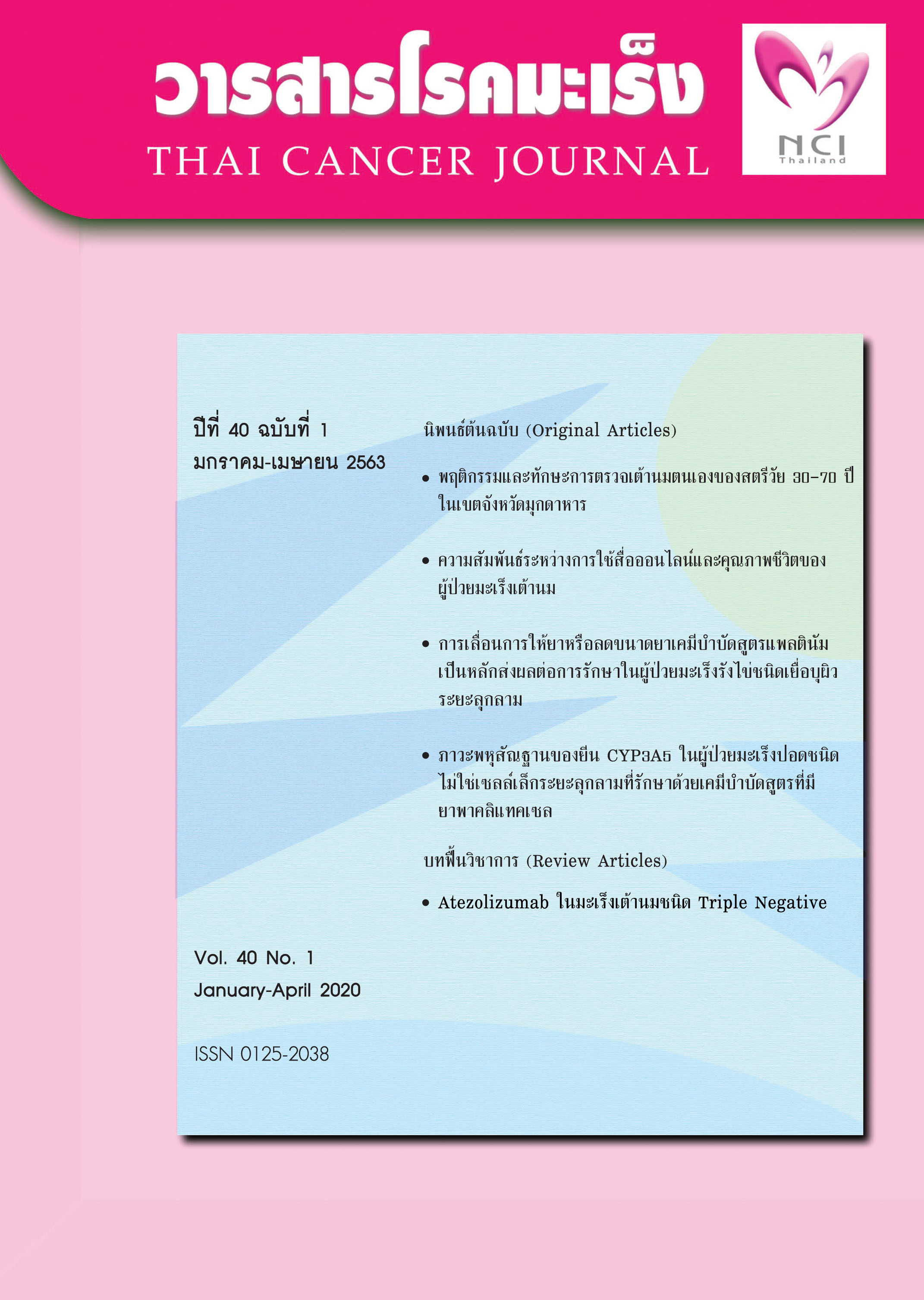Genetic Polymorphism of CYP3A5 in Advanced Non-Small-Cell Lung Cancer Patients Treated with Paclitaxel-Based Chemotherapy
Keywords:
Paclitaxel, chemotherapy, non-small-cell lung cancer, genetic polymorphism, CYP3A5Abstract
Paclitaxel, an anticancer drug, is recommended first-line therapy for patients with advanced
non-small-cell lung cancer. Genetic polymorphisms of Paclitaxel's metabolic pathway may affect
treatment outcomes and adverse events. The purpose of this study was to explore the prevalence of
CYP3A5 rs776746 and determine the association of genetic polymorphism and treatment outcomes
in Thai NSCLC treated with Paclitaxel-based chemotherapy. Among 49 patients, the prevalence of
CYP3A5*3 was 67.5%; the number of patients with CYP3A5*1/*1, CYP3A5*1/*3 and CYP3A5*3/*3
were 4, 30 and 24 persons, or 6.9%, 51.7% and 41.4%, respectively. The response rate of patients with
*1/*1 and *1/*3 was 31%, while the response rate of patients with *3/*3 was 25%. The most common
adverse symptoms found in this study was peripheral neuropathy (69.4%). The other common adverse
events were anemia and neutropenia, at 65.3% and 42.8%, respectively. Grade 3 or 4 anemia were
found in 10.2% of patients and grade 3-4 neutropenia 8.2%. The incidence of grade 3 or 4 hematologic
toxicity among patients with CYP3A5*3/*3 was higher than CYP3A5*1 (25% vs 17.2%). This study
found that CYP3A5 polymorphism was not associated with treatment outcomes or adverse events in
Paclitaxel-based chemotherapy among Thai advanced-NSCLC patients. However, our study indicated
that NSCLC patients with a family history of cancer had significantly greater disease progression
(6.75 times; 95% CI=1.67-27.34, P = 0.005) compared with cases with no family history of
cancer
References
World Health Organization. Cancer fact sheet February 2017 Available from: http://www.who.int/
mediacentre/factsheets/fs297/en/. Accessed July 15,2017
American Cancer Society. Global cancer facts &figures 2016. Atlanta: American Cancer Society;2016.
สำนักโรคไม่ติดต่อ กรมควบคุมโรค กระทรวงสาธารณสุข.รายงานประจำปี 2558.กรุงเทพฯ:สำนักงานกิจการ
โรงพิมพ์องค์การสงเคราะห์ทหารผ่านศึกในพระบรม-ราชูปถัมภ์; 2559.
สถาบันมะเร็งแห่งชาติ กรมการแพทย์ กระทรวงสาธารณสุข .แนวทางการตรวจวินิจฉัยและรักษาโรคมะเร็งปอด.
โฆสิตการพิมพ์; 2558.
National comprehensive cancer network. NCCN clinical practice guideline in oncology (NCCN guideline)
non-small cell lung cancer version 2.2018 Available from: https://www.nccn.org/professionals/
physician_gls/pdf/nscl.pdf. Accessed December 24,2017
Oshiro C, Marsh S, Mcleod H, et al. Taxane pathway. Pharmacogenet Genomics 2009;19:979-83.
Kuehl P, Zhang J, Lin Y, Lamba J, Assem M, Schuetz characterization of the genetic basic of polymorphic
CYP3A5 expression. Nat Genet 2001;27:383-91.
Gandara DR, Kawaguchi T, Crowley LJ, et al. Japanese-US common-arm analysis of paclitaxel plus
carboplatin in advance non-small-cell lung cancer:a model for assessing population-related pharmacogenomics.
J Clin Oncol 2009;27:3540-6.
Supanya D, Tassaneeyakul W, Sirivongs D, Pongskul C, Reungjui S, Avihingsanon Y, et al. Prevalence of
CYP3A5 polymorphism in a Thai population. Thai J Pharmacol 2009;31:95-7
Jiang LP, Zhu ZT, CY H. Effects of CYP3A5 genetic polymorphism and smoking on the prognosis of nonsmall-
cell lung cancer. Onco Targets Ther 2016;9:1461-9.
Leskela S, Jara C, Leando- Garcia LJ, Martinez A,Garcia-Donas J, S H. Polymorphisms in cytochromes
P450 2C8 and 3A5 are associated with paclitaxel neurotoxicity. Pharmacogenomics J 2011;11:121-9.
Hu L, Lv Q-L, Guo Y, Cheng L, Wu N-Y, Qin C-Z, et al. Genetic variation of CYP3A5 influences paclitaxel/
carboplatin-induced toxicity in Chinese epithelial ovarian cancer patients. J Clin Pharmacol 2016; 56:349-54.
Gréen H, Khan MS, Jakobsen-Falk I, Åvall-Lundqvist E, Peterson C. Impact of CYP3A5*3 and CYP2C8-
HapC on Paclitaxel/Carboplatin-induced myelosuppression in patients with ovarian cancer. J Pharm
Sci 2011;100:4205-9.
Henningsson A, Marsh S, Loos WJ, Karlsson MO, Garsa A, Mross K, et al. Association of CYP2C8,
CYP3A4, CYP3A5 and ABCB1 polymorphisms with the pharmacokinetics of paclitaxel. Clin Cancer Res
;11:8097-104.
Marsh S, Paul J, King CR, Gifford G, McLeod HL,Brown R. Pharmacogenetic assessment of toxicity
and outcome after platinum plus taxane chemotherapyin ovarian cancer: the Scottish Randomised
Trial in Ovarian Cancer. J Clin Oncol 2007; 25:4528-35.
Eisenhauer EA, Therasse P, Bogaerts J, Schwartz LH, Sargent D, Ford R, et al. New response evaluation
criteria in solid tumours: revised RECIST guideline (version 1.1). Eur J Cancer 2009;45:228-47.
National cancer institute. Common terminology criteria for adverse events (CTCAE) version 4.03:
U.S. Department of health and human services; 2010.J, et al. Sequence diversity in CYP3A promotors and
human services; 2010.
Park HS, Lim SM, Shin HJ, Cho A, Shin J-G, Lee MG,et al. Pharmacogenetic analysis of advanced nonsmall-
cell lung cancer patients treated with first-line paclitaxel and carboplatin chemotherapy. Pharmacogenet
Genomics 2016;26:116-25.
Hustert E, Haberl M, Burk O, Wolbold R, He Y-Q, Klein K, et al. The genetic determinants of the CYP3A5
polymorphism. Pharmacogenet Genomics 2001;11:773-9.
Downloads
Published
Issue
Section
License
บทความทีตีพิมพ์ในวารสารโรคมะเร็งนี้ถือว่าเป็นลิขสิทธิ์ของมูลนิธิสถาบันมะเร็งแห่งชาติ และผลงานวิชาการหรือวิจัยของคณะผู้เขียน ไม่ใช่ความคิดเห็นของบรรณาธิการหรือผู้จัดทํา







